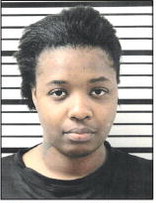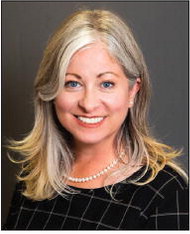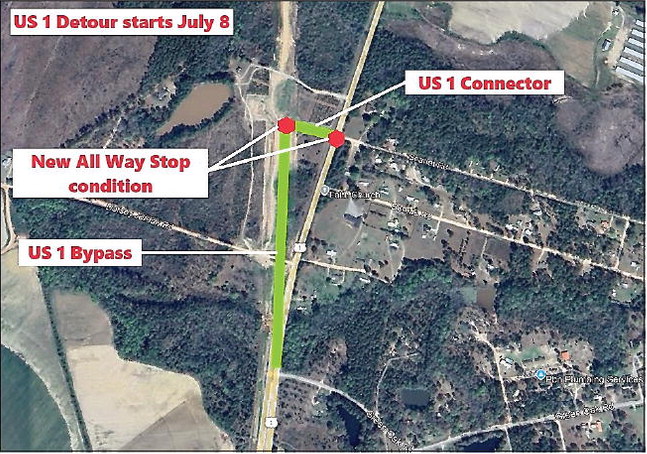Meadows Hospital’s Emergency Department Ahead of the Curve
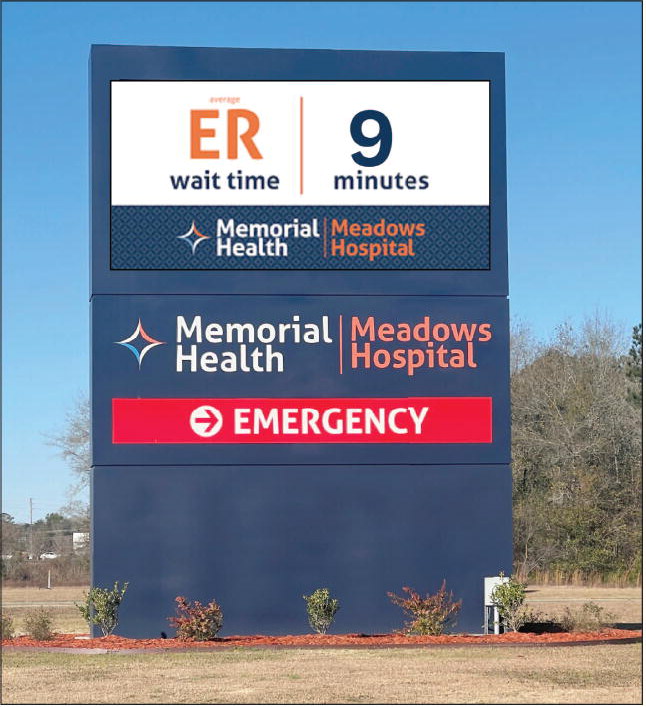

About 100 patients are treated each day at the Emergency Department of Memorial Health Meadows Hospital in Vidalia. The figures fluctuate, but the number of patients averaged 107 daily in 2023. Ailments can range from an upset stomach to a gunshot wound or a heart attack. Some walk through the Department’s entrance located on the front side of the hospital, and some arrive by ambulance at the Level 4 trauma center. Triaging of patients allows for the immediate treatment of the most critically ill, but every patient, no matter their medical need, can expect the same kind of reception. They are treated with compassion.
Dr. Glen Bunn, who is now in his second year as Medical Director of Meadows’ ED, came on board in 2018. So did Haley Powell, who moved up quickly through the ranks to become the Department’s Director. Her talent was recognized as she was named the facility’s 2023 Leader of the Year. The team’s ability to partner as a medical leader and a clinical leader and to deliver quality health care is known as a dyad model, said MHMH CEO Matt Hasbrouck.
“What Haley Powell and Dr. Bunn have done in the last year is absolutely remarkable. When we look at patient experience surveys, physician and employee engagement surveys, growth, quality scores, and various operational throughput metrics, they have increased in each of those areas by double digits,” Hasbrouck said.
When Dr. Bunn first came to Meadows and began working in the ED, the Department was seeing 75 to 80 patients a day. ED traffic has been climbing ever since, ballooning when the COVID pandemic struck in 2020. Like all medical facilities, Meadows had to deal with unprecedented challenges during the pandemic, but with all of that behind them now, the ED team regrouped and worked hard to create an efficient and improved environment which benefits both patients and staff.
“You have to depend on your team, and I feel like in the last year and a half we have gotten more tight-knit,” Bunn said of the ED staff. Since he has been at Meadows, the ED has had three core physicians, himself and two others, including Dr. Robert Wagner, who has been on the ED staff since 2017 and is a board-certified emergency physician.
The physicians who staff Meadows’ ED are contract employees, but all other employees are permanent Meadows staff. “It is unusual to have the same team in an emergency department over a long period of time,” Bunn said. Now, two full-time physicians certified in emergency medicine are on duty at Meadows’ ED and are there for the foreseeable future, Bunn explained. Currently, there are eight core physicians and eight mid-level staff — nurse practitioners and physician assistants. All total, the Department has 70 health care providers.
Powell said of the changes that have taken place in the ED, “We have optimized space and utilized space differently” to facilitate patient manage- ment. "We grew by 7.5% last year— with our patient load and staff. “ A former Infusion center adjacent to the ED was converted into an ED fast-track area. “We implemented a couple of hallway beds with privacy curtains,” to accommodate patient influx so that patients could be brought as quickly as possible from the waiting area into the Department, Powell illustrated.
Powell added, “Because of COVID we started treating patients differently for a time. We changed our entire throughput process in February (2023). Now, the time the patient walks through the door to going home has been markedly diminished because of the new throughput practices. The hospital’s electronic billboard announces that patients can expect much shorter wait times in ED — as low as 10 minutes in 2023. “We stopped first assessing the patient in the waiting area and immediately put patients into a room where nurses and practitioners see the patient more quickly and the patient is discharged more quickly,” Powell noted.
Dr. Bunn said of the process, “In any emergency department, the fewer places the patient has to go the better. The least amount of movement possible is best for the patient and staff. Patients won’t get lost in the shuffle from room to room. During COVID, with such a massive influx of sick people, we treated patients any way we could. Once that died down, we decided we had to step back and regroup.” As challenging as it was, the COVID experience presented multiple learning opportunities, from throughput to transfers, Dr. Bunn affirmed.
Dr. Bunn said that the Meadows ED is capable of handling the gamut of injuries and illnesses that present themselves at the door. “We can stabilize just about anything. Big internal injuries are transferred to a Level 1 trauma center.” Meadows’ partner facility, Memorial Health University Medical Center in Savannah, a Level 1 trauma center, usually receives air ambulance transfers from Meadows. There are also several other Level 1 medical facilities across the state that can accept the most critical cases. But, because of the number of medical specialties now located in Toombs County and affiliated with Meadows, patients can expect more specialized care closer to home.
Hasbrouck explained that there are four trauma levels, with level 1 being the best equipped to handle emergent and comprehensive care. “There is a big push to identify and develop level 3 and level 4 medical facilities in rural areas that don’t have access to medical resources. But that designation comes with challenges such as medical requirements, staffing, and community partnerships. Meadows is one of only a handful of level 4 trauma centers.”
He said that Meadows is very proud of its Level 4 trauma center designation. “Obviously, we want to do more, but to proceed to the next levels, there are increased criteria.”
Meadows has not only kept pace with community growth and needs, it has outpaced that growth, Hasbrouck believes. The medical center offers a Cardiac Center and Stroke Center, and an award-winning Maternal Health Center, among other amenities. He said, “We have doubled the number of subspecialists since 2018. We have a tremendous partnership with the region and its emergency medical transport services (ground and air ambulances), and we want to be the region’s first stop for emergency care.”
Hasbrouck continued, “We have board-certified emergency medical physicians, which is unique for an area this size. Our physicians have gone through additional training in emergency medicine and have been validated through their association and boards. That is not easy.” Dr. Bunn: From Grenada to Vidalia Dr. Bunn, who is a board-certified emergency physician, explained that physicians have to go through a residency in emergency medicine to get credentials, which is followed by rigorous board testing through the American Board of Emergency Medicine.
He served his medical residency in Saginaw, Michigan, through Central Michigan University. His undergraduate degree was earned at Georgia State University in Atlanta, and he completed medical school at St. George University in Grenada. He chose Grenada to earn his medical degree because in the U.S. it would have taken about a year to get into medical school and he was anxious to start his career. He spent two years in Grenada and the last two years in the New York-New Jersey area where the school has clinical sites. While there, he applied to Central Michigan University for a residency in emergency medicine.
He specifically chose to specialize in emergency medicine because of its more flexible application. “For me, I wanted to be the doctor that if you are anywhere you could help no matter what. I knew I wanted to be somewhere rural, but I did not know where. As an emergency physician, you can work anywhere. It’s not like certain specialties where you have to be in a big city to practice.”
Dr. Bunn grew up in Henry County, and his family is friends with Mark Spivey, an orthopedic specialist in Vidalia. Dr. Bunn spent some time with Dr. Spivey while he was still in medical school and knew Toombs County was where he wanted to practice one day.
“The emergency medicine specialty as a subspecialty is not very old,” Dr. Bunn noted. “When President John F. Kennedy was shot in Dallas, Texas, in 1963, they took the most important man in the world to a ‘room’ because it was literally just a room in a hospital staffed by surgical interns who had been doctors less than a year.” Incidentally, that is where the abbreviation “ER” came from when emergency rooms were literally just rooms where trauma patients were treated.
“After that, the thinking was that we need to have people who specialize in emergency medicine — not for patients to be seen by whomever was there at the time. From where it started and to where it is now with rolling ERs in ambulances and air care, everybody in the U.S. now has access to health care,” Dr. Bunn informed.
“My first job was coming to Meadows’ Emergency Department, and I am still here. I beat the statis- tics: about 50% of medical professionals change jobs in their first five years,” he said.
Haley Powell: Hometown Success Story Emergency Department Director Haley Powell is a Toombs County native who earned a degree at East Georgia College in Swainsboro and finished her degree in nursing at Middle Georgia College in Cochran. She worked in the medical-surgical unit at Emanuel Medical Center in Swainsboro, but that unit was not where she wanted to be as her career progressed. “I knew I wanted to work in emergency medicine. I like never knowing what is going to come through the door, or having zero to 60 patients on the board in 30 minutes. I thrive on challenges.”
Her first job at Meadows’ Emergency Department was as a part-time nurse. In 2018 she became a full-time nurse and then Emergency Department manager. In January of 2023 she was promoted to Interim Director of the Department, and in May was named Director. “As Director I assume all responsibility for the operation of the Department by Meadows staff. I am on call 24/7.” Powell actually had her first experience at Meadows as a member of the MHMH Youth Advisory Group, an organization which offers select high school students an opportunity to learn firsthand about health care as a potential career while being a part of the hospital environment.
“She’s now a member of Meadows’ leadership. She is a tremendous success story for our community,” Hasbrouck said. Future of Emergency Medicine What do the medical professionals see on the horizon for emergency medicine?
“Emergency medicine is doing more primary care than ever, the numbers back it up,” Dr. Bunn said. “Primary care is so overrun community-wide, despite the number of doctors’ offices and emergency clinics which are available. Often, these patients have nowhere else to go but to the local hospital emergency department. We are open 24/365, so people are always on our doorstep.”
At the local hospital’s ED, care is immediate and patients can get instantaneous results, so EDs are becoming more popular as primary care options. “I don’t know if this is good or bad for emergency medicine long-term, but it is what it is. We have to see volume; that is how emergency departments are run. Here, we have been very dynamic; as we have seen a rise in primary care we have been able to accommodate that,” Dr. Bunn observed.
Powell noted, “We see patients from at least a 60mile radius. People say it is different at Meadows because they are treated like
“We see patients from at least a 60-mile radius. People say it is different at Meadows because they are treated like more than just a patient. I tell my staff, ‘treat every patient as if they are a family member.’”
— Haley Powell, MHMH Emergency Department Director continued from page
more than just a patient. I tell my staff, ‘treat every patient as if they are a family member.’ “ Hasbrouck affirmed, “More people are bypassing other medical centers to get care here. Why? The experience. They will be treated with compassion and we will communicate with them. From emergent needs to primary care, if a patient comes through our door, we will treat them like family.”
Hasbrouck said that because of its commitment to a continuum of care in the community and the region, Meadows has an “obligation and expectation to serve anybody who comes through that door, no matter what their situation or emergency.”
Hasbrouck stressed that the Emergency Department is the front door to the hospital. About 70% of the patients upstairs receiving inpatient acute care came through the ED. “The ED staff is the face of the hospital. If patients come through ED, these are the folks these patients see first and we make sure we put our best foot forward every time, consistently. They lead that. That is why I think it is so important for the public to know about this staff and what they do together to uphold our mission and deliver exceptional care.”
Hasbrouck added, “Our goal and vision is to have care closer to home. More people are choosing to come to our ED because they receive great care, there are great providers, and they have access to that next level of care. If we can keep people close to home, it is so much better for the healing process. Our challenge is finding ways to continue to raise the bar, but right now we are providing big- time medicine in this community.”
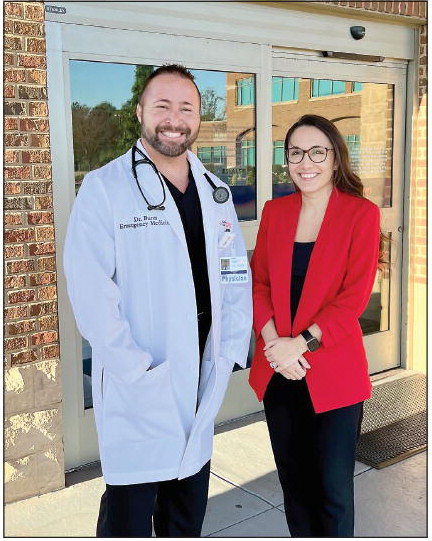
TEAMWORK — Dr. Glen Bunn, left, who is now in his second year as Medical Director of Meadows’ ED, came on board in 2018. So did Haley Powell, right, who moved up quickly through the ranks to become the Department’s Director. The team’s ability to partner as a medical leader and a clinical leader has facilitated the delivery of quality health care at MHMH’s Emergency Department.



